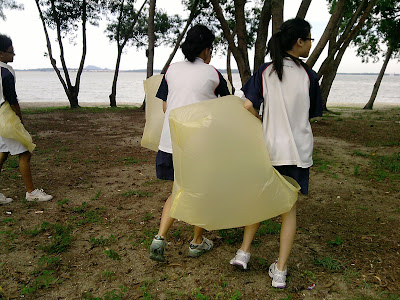Happy New Year to all! It has been tough juggling two blogs this
term (GEOG3038: The Value of Water), but I have enjoyed every bit of it.
My initial motivations for the blog were triggered from the senseless comments following a Facebook status on plastic bag charging, although during then I merely had a general impression of plastics being harmful in no specificity.
Slowly, I started to doubt the continued marketing of plastic bags as "recyclable"
or "biodegradable", as the sighting of bags in water bodies or shorelines obviously challenges these intentions by the manufacturer.
The large releases of microplastics through sewage systems by fleece and exfoliating products took me by surprise, and I realised how
ubiquitous plastic was in our lives. Consequently, I hoped to impart greater awareness on the impacts of plastic bags on marine life and even human
health.
I became increasingly conscious of the plastic that
comes in packaging - when I Clicked & Collected a new
dress from Uniqlo, I was somewhat embarrassed that my dress was wrapped in its
original plastic bag, which was wrapped in another bigger plastic, which was
wrapped with another plastic envelope with my address written. I felt compelled
to reuse the layers of plastic packaging as bin liners to justify the excessive
purchase, and I suppose my blogging journey has definitely positively reshaped my
mindset towards plastic packaging. Unfortunately, although alternative materials for packaging are popularly encouraged, they may not be ideal. I once mentioned that cotton reusable tote bags could easily
substitute for plastic bags quoting what I usually did myself; it was then
somewhat disconcerting for me to realise that the overall environmental demand from manufacturing a cotton bag or paper bags was way greater than a plastic bag (in response to Figure 4). Nonetheless, I will still try to reuse
plastic bags, although admittedly single-use is unavoidable when it comes to collecting food
waste and cooking oil as I avoid pouring them down the sink (in response to Figure 3).
While global frameworks exist as guidelines, local enforcement is most important to fix the dumping problem. In the future, I do
hope that I would get to observe local action plans to prevent dumping of plastic waste in Singapore’s waters, as I have personally witnessed mass overboard dumping
of huge garbage bags containing styrofoam packaging and food
waste by other ships, as a "future sailor" if you noticed in my biography. I hope my blog has reshaped your mindsets towards plastic as well, and that ignorant comments by lazy and selfish netizens (seen in Figure 2) should irritate you more now.
If you happen to enjoy my writing, do read more on my personal blog. Hope you had a wonderful term!
If you happen to enjoy my writing, do read more on my personal blog. Hope you had a wonderful term!

